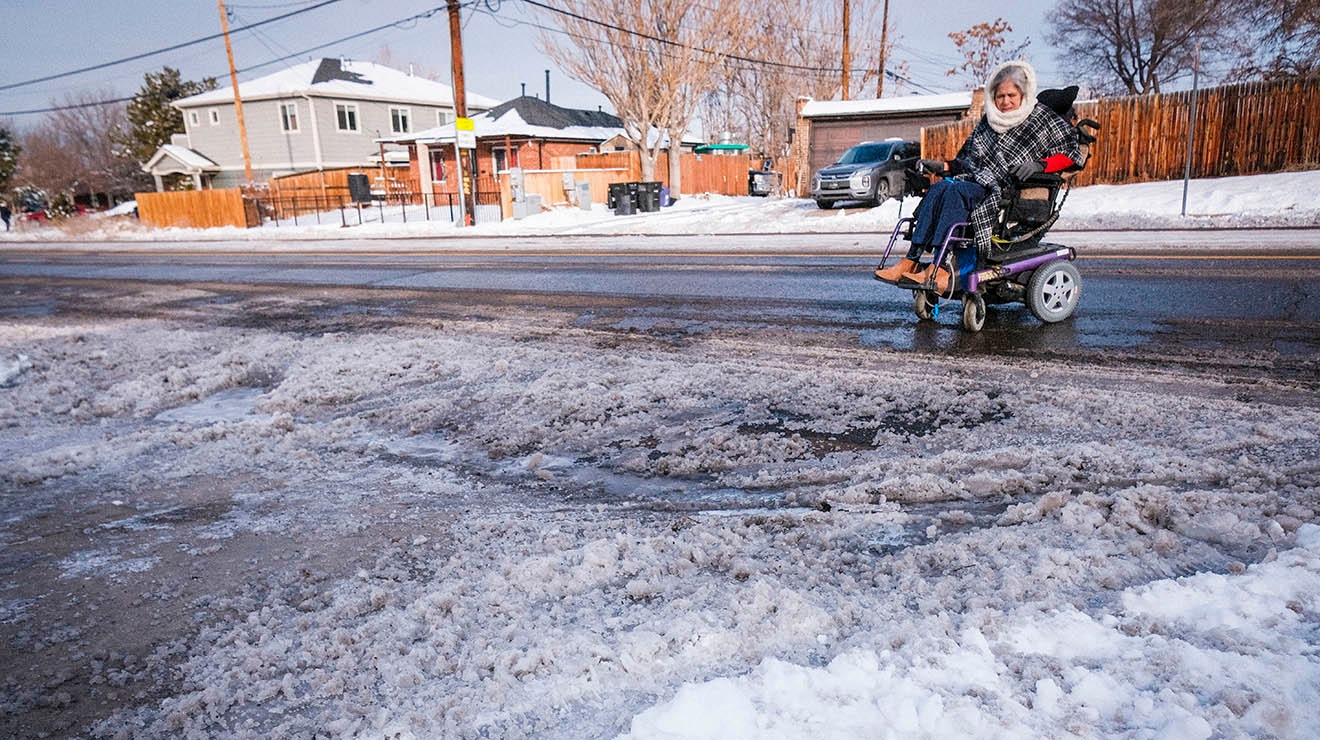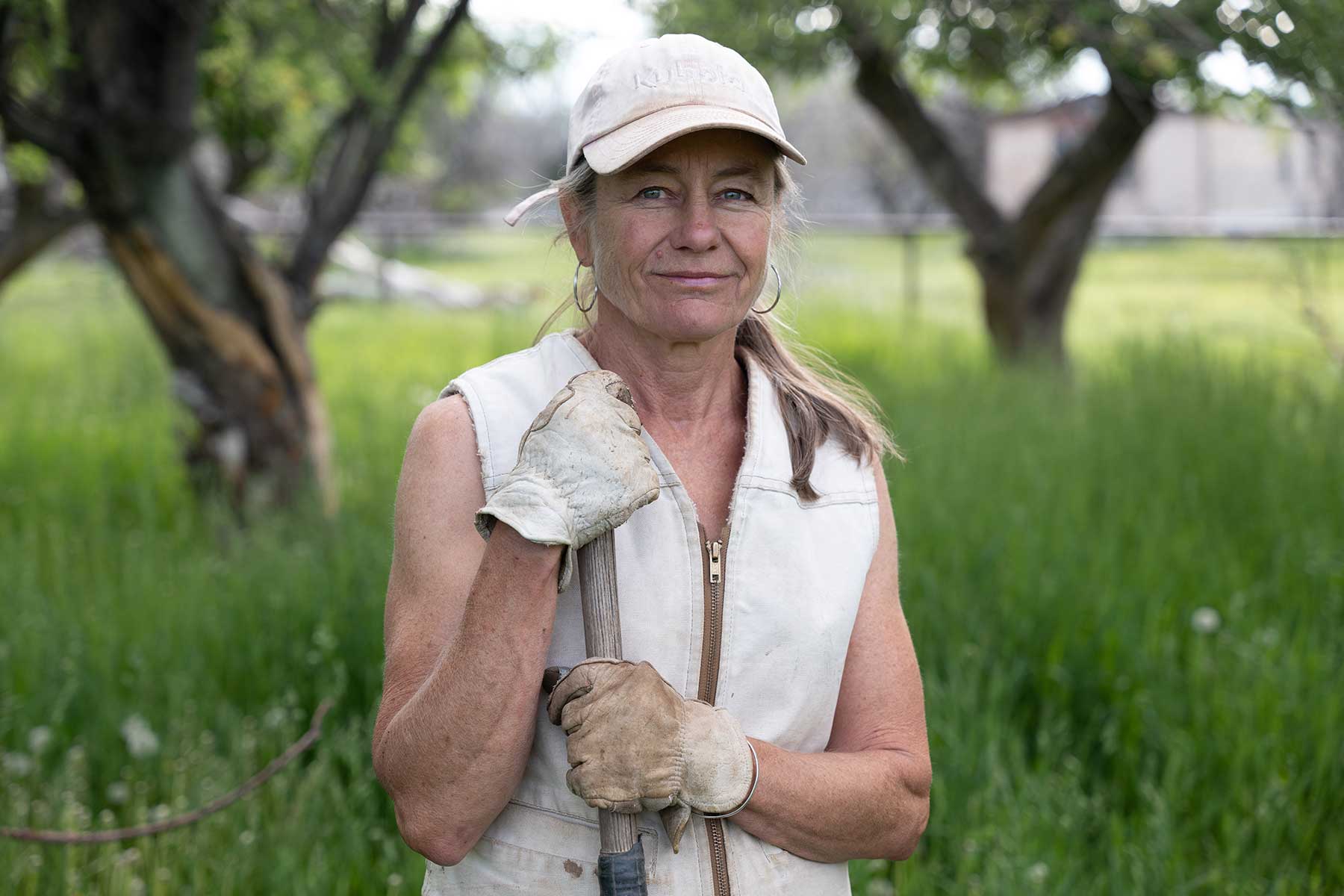For nearly two weeks after a late December snowstorm that left 7 inches of snow on the ground in Denver, when resident Julie Reiskin needed to leave her home on Milwaukee and 37th, she had to roll her wheelchair down the middle of busy streets and then station herself in the street to flag down a public bus.
That experience, she said, was “terrifying.” And it was due to Denver’s snow plowing protocol.
“A lot of times, the sidewalks will be shoveled, but the curb cut that lets us get on and off isn’t,” explained Reiskin, co-executive director of the Colorado Cross-Disability Coalition (CCDC), a social services agency that advocates for disability rights. (CCDC is a Colorado Trust grantee.)
“So then we’re forced to roll in the street… and when the streets are filled with ice and slush, the only place we can go is on the busiest streets, and in the middle of the street.”
Denver’s snow plowing response was widely criticized following the December storm, when a sustained cold snap combined with the city’s failure to deploy side-street plows caused mounds of snow and ice to languish for weeks. In response, the city upped its plowing efforts for the Jan. 17-18 storm, dispatching small plows to clear residential streets. Still, due to a sidewalk clearing system that relies heavily on business and private property owners to ensure sidewalks and curbs are accessible, problem areas have inevitably remained.
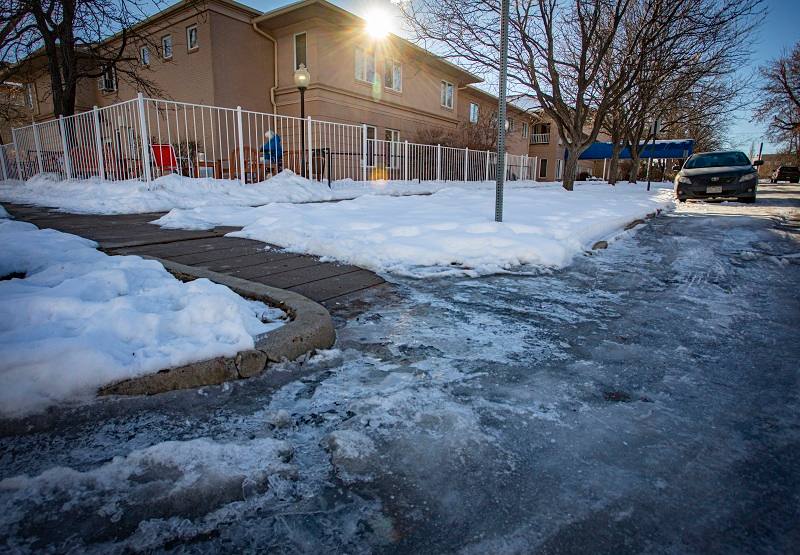
Frozen snow and ice block a curb cut on a street corner in Denver on Jan. 10, 2023—nearly two weeks after the previous snow storm.
This issue is nothing new for Denver, said Reiskin, who has lived in the city since 1994. And though unplowed and icy walkways impact all pedestrians, they are even more challenging for people who use wheelchairs, walkers and other mobility devices to navigate the streets and sidewalks. In Denver, 6.7% of residents under the age of 65 have a disability, and 12.2% of the city’s population is 65 or older, according to the latest census data.
In the aftermath of the late December storm, Chris Hinds, Denver city councilman for District 10 and a resident who uses a wheelchair, had to roll down the streets of Broadway and Park Avenue West because icy curb ramps prevented him from accessing the sidewalks.
“We all should have equitable access to get around our city,” said Hinds.
In Denver, street plowing is managed by the Department of Transportation & Infrastructure (DOTI), which maintains 70 larger plows as well as 36 smaller residential-street plows. “Denver responds to most snowstorms with full deployment of its big plows to the main streets,” DOTI Communications Director Nancy Kuhn said via email. Main streets are defined as most streets with painted stripes. Small plows, said Kuhn, are sent to residential streets “when the city is expecting a significant snowfall event and the small trucks could be helpful in clearing a path for motorists to get to the main streets.”
By contrast, sidewalk clearing is the responsibility of the adjacent property owner. By Denver law, property owners are supposed to remove snow and ice from their sidewalks, including adjacent mobility device ramps and bus stops not owned by the Regional Transportation District (RTD), as well as curb cuts if the residence or business is on the corner of a block. RTD is responsible for shoveling their owned bus shelters, said Kuhn.
Business owners have four hours to clear snow after a storm lets up, and residents have 24 hours. City inspectors, who are managed by the city’s Community Planning and Development department, enforce sidewalk shoveling.
Inspectors generally rely on community members to call 311 with complaints. If residents or businesses don’t respond to the city’s warnings, they can face fines of up to $150.
The current sidewalk shoveling protocol “is kind of how we’ve operated for a number of years now,” said Amanda Weston, spokesperson for Community Planning and Development. She said the department is thinking of distributing fliers in especially busy areas of the city to educate property owners of the law.
From Dec. 28, 2022 to Jan. 12, 2023, in the wake of the seven inches of snow that fell, the city received 2,479 complaints regarding unshoveled sidewalks, according to Weston. Only 35 properties failed to comply after receiving inspector warnings and thus received a $150 fine.
“What we find is, once people know, and once we’ve informed them that they have a problem area that they need to take care of, the compliance rate is extremely high,” she said.
In terms of how quickly inspectors respond to complaints, “they’re pretty good about getting there in that timely manner,” said Weston. But because residents have 24 hours to shovel following a storm, plus any lag time from the end of that 24-hour window to when an inspector shows up—plus another 24 hours to take care of any areas pointed out during the inspection—sidewalks and curbs could go unshoveled for days.
Moreover, “all it takes is one property owner to not shovel,” said Jill Locantore, executive director of Denver Streets Partnership, a coalition of community organizations that advocate for pedestrian-friendly streets in Denver. “If the rest of the block is beautifully shoveled and clear of snow, but the last 10, 20 feet is a disaster, that can make it completely impassable for a person in a wheelchair and a safety hazard for anybody who’s walking who could trip and fall.”
Additionally, the areas surrounding bus stops—which, as mentioned, are sometimes the shoveling responsibility of private property owners and not RTD—can be especially problematic.
“You see this often on Colorado and 26th, around there—they’ll clear the sidewalk, but they won’t clear the path to the bus stop,” said Reiskin. “So there’s a path on the sidewalk, and if you wanted to actually get to the bus stop in a wheelchair, you couldn’t.”

Snow mounds surround a bus stop in central Denver on Jan. 10, 2023.
On an early January day, Jonathon Stalls, founder of Pedestrian Dignity, a network of people that advocate for pedestrian mobility, pointed to a tall, thick sheet of bumpy ice that formed at the bus stop on Colorado Boulevard between Sixth and Seventh Avenue after the December storm. Stalls, who documented the scene and shared it on TikTok, explained that the ice mound formed as a result of city plows pushing snow from the streets onto the sidewalks as well as the high volume of people who travel to and from the bus stop compacting unplowed snow, turning it into ice. Temperatures just above freezing during the day and below freezing at night further contribute to the problem.
“If you’re on a powered scooter or wheelchair, you’re just not taking the bus or you’re literally in the road,” said Stalls. “But if you’re able-bodied enough to navigate the ice, you have to climb over this plowed ice hill to get to the bus.”
Denver’s current snow removal policies “came from an outdated mentality of the most important thing is to assist people driving to get where they need to go,” said Locantore, “as opposed to thinking more holistically about we need to help people get where they need to go, and they’re going to use a variety of modes to get there—whether it’s transit or walking or biking.
“Driving is part of the mix. But it shouldn’t be the only consideration in terms of how we’re doing snow removal policies.”
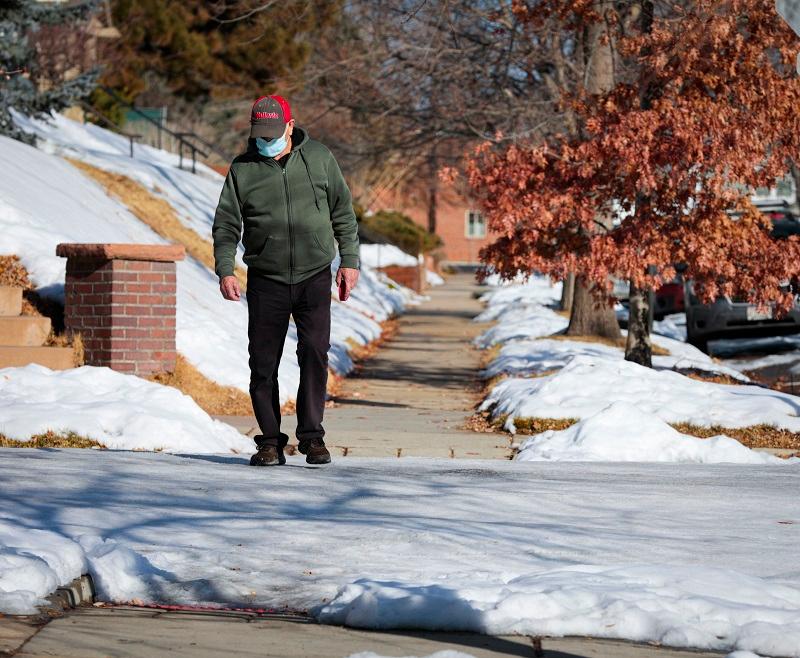
A pedestrian navigates a snow-covered street in Denver on Jan. 10, 2023. Snow and ice lingered on residential streets for weeks after a late December snowstorm.
In addition to the fear and danger of having to roll down the middle of busy streets, people using wheelchairs must also contend with the reality of getting their wheels stuck on unplowed streets, sidewalks or curb ramps. When the temperatures are low, “if you get stuck, and there’s no one around and you’ve got to wait until someone comes by, that can be very dangerous,” said Reiskin.
Indeed, following a snowstorm in November 2019, Hinds, the city councilman, got stuck in the snow for 45 minutes while trying to return home after a council meeting. He spent two days hospitalized with resulting health complications.
Additionally, people in motorized wheelchairs risk damaging their devices and getting stranded if they roll through deep puddles of water, which tend to form on corner curb cuts as snow and ice start to melt. “I’ve heard from people who their [wheelchair] batteries have cut out because they got immersed in water, and then they were stranded with a non-functioning battery,” said Locantore.
Poor road and sidewalk conditions can also leave some people with disabilities stuck in their homes. After the December snowstorm, Phyllis Mack, who uses a motorized wheelchair, didn’t leave her Ruby Hill apartment building for seven days straight. Mack, 75, often takes public transportation to get around the city, and though the sidewalks in front of her building were plowed after the storm, the street was not, so she couldn’t navigate to the bus stop.
Mack called 311 and was told someone would plow the street. “But nobody came,” she said.
“I just wish they will come down and plow the street so we can get out and we’re not stranded in our apartments,” said Mack, who lives in Walsh Manor, a public housing building for people who are elderly and live with disabilities.
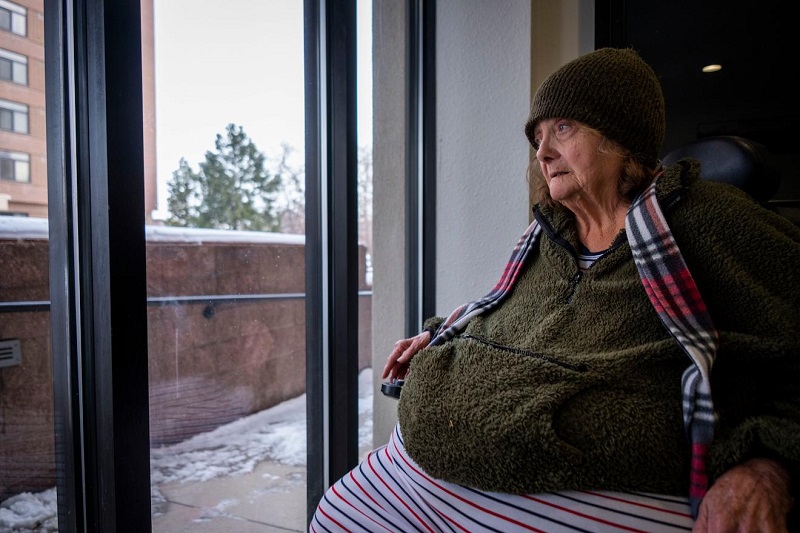
Phyllis Mack in the Walsh Manor lobby on Jan. 20, 2023.
Jaime Lewis, a 64-year-old Denver resident who also uses a wheelchair, can relate to those feelings of isolation.
“I’m usually good for about two days inside, and then I started getting antsy,” said Lewis, the transit advisor for CCDC. Following the December storm, Lewis stayed in his Golden Triangle apartment building for four days, due to unplowed sidewalks and curb cuts that made it impossible for him to navigate his way around. He noticed that his depression “kind of heightened” as a result.
“I live in an apartment building that has really no amenities—there’s no gym, there’s no lobby, there’s really nothing, so it’s me and Zoom. And that’s it, so it can get old real fast,” said Lewis.
The inability to leave home can also limit people’s ability to access food. When navigating to the grocery store or food bank is impossible, people may order fast food delivery instead, said Reiskin.
“They might order a takeout pizza and eat that for three days,” she said. “It might be like, okay, well, is that such a huge deal? Well, if you’re borderline diabetic, yeah, it probably is a big deal if that’s how you’re eating.”
Reporting unplowed sidewalks, curb cuts and bus stops to the city can be a frustrating, ineffective experience, said Reiskin, who estimates that she has submitted 100-plus complaints over the years. Part of the frustration is with Denver’s PocketGov web tool, which requires users to submit specific street addresses for their complaints.
“Well, most bus stops don’t have an exact address,” said Reiskin. And for other locations—such as bridges or entire city blocks—it can be difficult to know what the correct address would be, especially if someone in a wheelchair can’t even physically get there due to snow. The last time Reiskin tried to submit a complaint via PocketGov, she typed in the address and the system said it didn’t exist.
“I was standing right next to it, so it did exist,” she said. Then, she tried to use the “My Location” feature to auto-populate the address. That was unsuccessful, so the system then prompted her to provide an intersection. “I gave an intersection, and they said it wasn’t specific enough,” she said.
Weston said she hadn’t heard of issues inputting addresses into PocketGov, but suggested people call 311 and talk to a live agent as a possible solution to that problem.
But even when users can submit a complaint under an exact address, it doesn’t always resolve the issue. Some property owners are repeat offenders. For example, CCDC has an office on South Colorado Boulevard and East Louisiana Avenue, and CCDC reported a nearby business multiple times each year for failing to clear their adjacent sidewalk. “It made it impossible for us to get to the bus stop,” Reiskin said. She’s unsure what the city did in response to their complaints, but the situation “never changed, so there’s no progress.”

Reiskin has had to roll her wheelchair down the middle of busy streets like Colorado Boulevard and York Avenue in the past when sidewalks and curb cuts were inaccessible due to snow.
Recent efforts have been made to improve pedestrian mobility in Denver. For example, in the November 2022 election, voters approved Ordinance 307, known as Denver Deserves Sidewalks, which funds the construction and repair of sidewalks across the city. And Mack, the Walsh Manor resident, recently helped lead efforts to allocate $400,000 in the city’s new participatory budget program to widen and smooth the sidewalks in her neighborhood. Still, when it comes to snow removal, more emphasis needs to be placed on clearing sidewalks, curbs and bus stops, advocates said.
“It’s our position at CCDC that the Americans with Disabilities Act requires local government to maintain accessible features,” said Reiskin. “And so when the city ignores enforcement [of sidewalk shoveling], that is a failure to maintain an accessible feature.”
Weston, with the Community Planning and Development department, pointed out that there are over 3,000 miles of sidewalks in the City and County of Denver. As such, “we just can’t be as proactive as I’m sure everybody, including the department, wishes we could be with enforcement of sidewalk shoveling.”
Kuhn, the DOTI spokesperson, said the city is interested in discussing improvements to the snow removal policy but that large-scale changes would require money the city doesn’t have right now, in part because of the strain on resources resulting from the COVID-19 pandemic. “There may be opportunities in upcoming budget cycles to reignite discussions about service level expansions that the administration and elected officials want to fund,” she said.
Over the years, Reiskin has discussed the issue of inadequate snow plowing with the city numerous times, she said. The typical response? “We always get lip service, we always get a meeting, and we get, quite frankly, excuses and maybe some promises,” she said.
Admittedly, the issue of citywide snow removal is big, nuanced, and unlikely a quick fix.
“It’s not like we can just demand that the city take on full responsibility for removing snow from every single sidewalk in the city without some massive funding source to make that happen,” said Locantore. “But just like the city doesn’t plow every single street when it snows and they have rationale and justification for doing that, there could be a decision that the city itself takes over snow removal on certain high-priority pedestrian locations.”
One example: the city already does manage plowing on park sidewalks, Locantore pointed out. She’d like to see the city expand on that.
In the meantime, Stalls encourages community members to keep making reports via 311 and PocketGov, despite their shortcomings. People can also submit videos of unplowed streets and sidewalks for reposting on Stalls’s Pedestrian Dignity social media accounts to help raise awareness. Beyond that, he encourages people to invite elected officials to come experience pedestrian challenges firsthand as well as help those with disabilities to document their experiences navigating treacherous conditions.
“There’s a huge gap between most of the population that makes big decisions on transportation… and the lived experience of someone trying to get through Alameda with a walker from the grocery store to their apartment,” he said.
